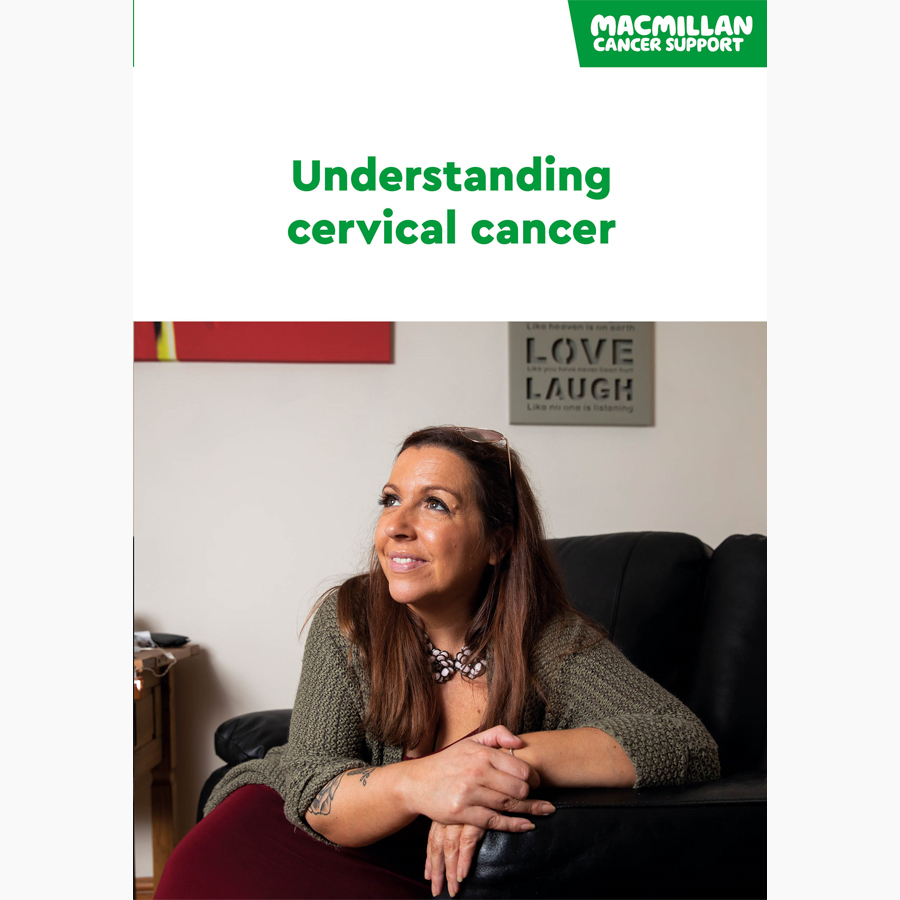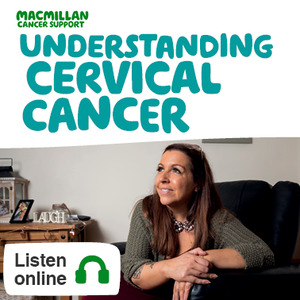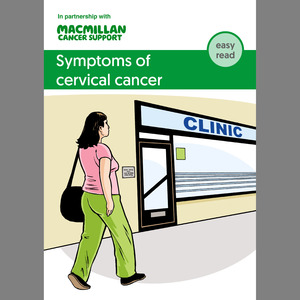Cervical cancer
What is cervical cancer?
Cervical cancer develops very slowly from abnormal cell changes in the cervix. These changes do not cause any symptoms, but they may be found with cervical screening tests. If the tests show abnormal cell changes, treatment can prevent cancer developing.
The cervix is the lower part of the womb (uterus) that joins to the top of the vagina. It is sometimes called the neck of the womb. People who have a cervix include women, transgender (trans) men and people assigned female at birth.
Each year, more than 3,200 women are diagnosed with cervical cancer in the UK. This type of cancer can affect all ages.
Types of cervical cancer
There are two main types of cervical cancer. The most common is squamous cell carcinoma. This develops from a type of cell that covers the outside of the cervix, at the top of the vagina.
The other type is adenocarcinoma. This develops from a different type of cell found in the cervical canal (the endocervix).
Rarer types of cervical cancer include:
- adenosquamous carcinoma
- clear cell carcinoma
- neuroendocrine carcinoma or small cell carcinoma of the cervix
- lymphoma
- sarcoma.
These types are much less common and may be treated differently. If you need more information, our cancer support specialists may be able to help.
Related pages
Booklets and resources
Symptoms of cervical cancer
Very early-stage cervical cancer may not cause any symptoms. It is usually found and treated because of cervical screening tests.
Common symptoms of cervical cancer include:
- heavier periods than you normally have
- vaginal bleeding between periods, after sex, or after the menopause.
We have more information about the signs and symptoms of cervical cancer.
If you get symptoms between your regular cervical screening appointments, do not wait for your next appointment. Talk to your GP or practice nurse and get checked. These symptoms can be embarrassing, but your GP or practice nurse will understand.
Causes of cervical cancer
The main risk factor for cervical cancer is an infection called the human papilloma virus (HPV). There are more than 100 types of this virus. Some types of HPV can affect the cervix and cause abnormal cell changes that may develop into cervical cancer.
We have more information about HPV and other causes and risk factors of cervical cancer.
Diagnosis of cervical cancer
If you have symptoms, you usually start by seeing your GP (local doctor). They will examine you and may refer you to the hospital for a specialist assessment and tests. If your GP thinks you may have cancer, they will refer you urgently to the hospital.
Cervical cancer may also be diagnosed during cervical screening. This is not common but sometimes happens.
We have more information about diagnosing cervical cancer.
Staging of cervical cancer
The stage of cervical cancer describes its size and whether it has spread from where it first started. Knowing the stage helps your doctors plan the best treatment for you.
We have more information about staging of cervical cancer.
Treatment for cervical cancer
A team of specialists will meet to discuss the best possible treatment for you. This is called a multidisciplinary team (MDT).
The treatment you have depends on:
- the stage of the cancer
- the size of the cancer
- your general health
- whether you have been through the menopause
- whether you want to get pregnant in future.
You and your specialist doctor will decide on the right treatment plan for you. Your doctor is an expert in the most effective treatments. But you know most about your own situation and preferences.
Protecting your fertility
If you want to get pregnant in the future, it is important to talk to your doctors about this. You may be able to have treatment that can protect your fertility. If this is not possible, your doctor can refer you to a fertility specialist. You can talk with the specialist about options such as having egg or embryo storage before treatment.
Types of treatment
You may have more than one of the treatments below. You may also have treatment as part of a clinical trial.
Treatments for cervical cancer may include:
-
Surgery
Surgery aims to remove all the cancer. Find out what happens before and after surgery.
-
Radiotherapy
Radiotherapy uses high-energy rays to destroy cancer cells. This may be used on its own or in combination with chemotherapy (chemoradiation).
-
Chemotherapy
Chemotherapy uses anti-cancer (cytotoxic) drugs to destroy cancer cells.
-
Targeted therapy
Targeted therapies are drugs that target something in or around the cancer cell that is helping it grow and survive.
-
Immunotherapy
The immune system protects the body against illness and infection. Immunotherapies are treatments that use the immune system to find and attack cancer cells. Nivolumab (Opdivo®) and ipilimumab (YERVOY®) are immunotherapy drugs that are starting to be used in cervical cancer treatment. At the moment, they can only be used as part of a clinical trial. Your doctor or nurse can give you more information about the right treatment for your situation.
Treating early-stage cervical cancer
Most cancers of the cervix are diagnosed at an early stage. Surgery is the main treatment. Radiotherapy or chemoradiation (radiotherapy given with chemotherapy) is sometimes used:
- instead of surgery, if you are not fit for a big operation or general anaesthetic
- after surgery, to reduce the risk of the cancer coming back.
Treating locally advanced cancer
Treating advanced-stage cancer
After cervical cancer treatment
Follow-up after treatment for cervical cancer
After your treatment has finished, you will have regular check-ups with your cancer doctor or nurse. These may include:
- a phone appointment
- a physical examination
- blood tests
- x-rays
- scans.
We have more information on follow-up care after treatment.
Even if you already have a healthy lifestyle, you may choose to make some positive lifestyle changes after treatment.
Making small changes such as eating well and keeping active can improve your health and well-being and help your body recover.
You may get anxious between appointments. This is natural. It may help to get support from family, friends or a support organisation.
Macmillan is also here to support you. If you would like to talk, you can:
- Call the Macmillan Support Line on 0808 808 00 00.
- Chat to our specialists online.
- Visit our cervical cancer forum to talk with people who have been affected by cervical cancer, share your experience, and ask an expert your questions.
Get this information in another language or format
We are committed to making our website as accessible as possible, to make sure that everyone can use it.
We have information about cervical cancer in over 16 languages, and in other formats including audiobooks, and easy read.
If we don't have what you are looking for, you can ask for information to be translated for free or provided in a format to suit you. Email us at cancerinformationteam@macmillan.org.uk or call us on 0808 808 00 00.
About our information
-
References
Below is a sample of the sources used in our cervical cancer, cervical screening and CIN information. If you would like more information about the sources we use, please contact us at cancerinformationteam@macmillan.org.uk
GOV.UK. Cervical screening: programme overview. Updated 18 November 2019. Available from www.gov.uk/guidance/cervical-screening-programme-overview (accessed March 2020).
GOV.UK. Colposcopic diagnosis, treatment and follow up. Updated 5 February 2020. Available from www.gov.uk/government/publications/cervical-screening-programme-and-colposcopy-management/3-colposcopic-diagnosis-treatment-and-follow-up (accessed April 2020).
Marth C, Landoni F, Mahner S, et al. Cervical cancer: ESMO clinical practice guidelines. Annals of Oncology, 2017; 28, suppl 4, iv72–iv83. Available from www.esmo.org/guidelines/gynaecological-cancers/cervical-cancer (accessed October 2020).
Reed N, Balega J, Barwick T, et al. British Gynaecological Cancer Society (BGCS) cervical cancer guidelines: recommendations for practice. 2020. Available from www.bgcs.org.uk/wp-content/uploads/2020/05/FINAL-Cx-Ca-Version-for-submission.pdf (accessed October 2020).
-
Reviewers
This information has been written, revised and edited by Macmillan Cancer Support’s Cancer Information Development team. It has been reviewed by expert medical and health professionals and people living with cancer. It has been approved by Senior Medical Editor, Professor Nick Reed, Consultant Clinical Oncologist.
Our cancer information has been awarded the PIF TICK. Created by the Patient Information Forum, this quality mark shows we meet PIF’s 10 criteria for trustworthy health information.
The language we use
We want everyone affected by cancer to feel our information is written for them.
We want our information to be as clear as possible. To do this, we try to:
- use plain English
- explain medical words
- use short sentences
- use illustrations to explain text
- structure the information clearly
- make sure important points are clear.
We use gender-inclusive language and talk to our readers as ‘you’ so that everyone feels included. Where clinically necessary we use the terms ‘men’ and ‘women’ or ‘male’ and ‘female’. For example, we do so when talking about parts of the body or mentioning statistics or research about who is affected.
You can read more about how we produce our information here.
Date reviewed
This content is currently being reviewed. New information will be coming soon.

Our cancer information meets the PIF TICK quality mark.
This means it is easy to use, up-to-date and based on the latest evidence. Learn more about how we produce our information.






